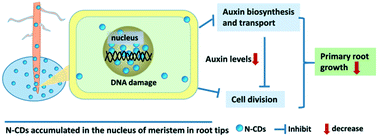Response of primary root to nitrogen-doped carbon dots in Arabidopsis thaliana: alterations in auxin level and cell division activity†
Abstract
Fluorescent carbon dots have attracted wide attention in the fields of bioscience and bioimaging. However, to date, the molecular mechanisms of the effects of carbon dots on plant growth and development have not been elucidated. In this study, the roots of Arabidopsis thaliana seedlings were treated with nitrogen-doped carbon dots (N-CDs). After 6 h, N-CDs entered and accumulated in the cell nucleus of the meristem in the primary root (PR). The transcription of 6 auxin synthesis-related genes was significantly down-regulated in the toxic reaction of N-CDs. N-CD treatment also reduced the expression of the auxin efflux carriers PIN1 and PIN2, and then decreased the level of auxin in the root tip, resulting in the inhibition of PR growth. Moreover, N-CD stress induced a downregulation in the expression of cell cycle regulation genes and DNA damage repair genes in the PR of Arabidopsis thaliana seedlings, thus decelerating cell division in the root tips. Finally, we proposed the molecular mechanisms of N-CDs inhibiting the PR growth. This is not only conducive to evaluate the ecological environmental safety of N-CDs, but also provides a reference to further understand the molecular mechanism of the toxic effect of N-CDs on plants.



 Please wait while we load your content...
Please wait while we load your content...